 Leading Blog | Posts by Month |
 Leading Blog | Posts by Month |
07.31.19

LeadershipNow 140: July 2019 Compilation
See more on
Posted by Michael McKinney at 08:47 AM
07.29.19

Feedback (and Other Dirty Words)
FEEDBACK HAS A LOT OF BAGGAGE associated with it. Feedback is not always well-intentioned and is used to punish, demean, or manipulate. When well-intentioned we don’t always do it right. We dump on people, we’re biased, we miss the overall issues, and present it in a way that doesn’t sound helpful. And we, of course, wanting to be right and accepted don’t see it as the gift that it is. As a result, you will find people avoiding it altogether—whether on the giving or receiving end of it. Or you will find people trying to take it to a higher lever and state that what we need and really want is attention. Positive attention is the way to go. Build on strengths. But sometimes we need to tame our strengths for our own good, and sometimes we need to manage our weaknesses. And frequently we have no idea unless we are told. We need feedback. In contrast to the desire of some to dumb down or avoid feedback, authors Tamra Chandler and Laura Grealish have decided to deal with feedback head-on in Feedback (and other dirty words): Why We Fear It, How to Fix It. Done right, feedback is not only a good thing, it is essential to growth and performance. They say we need to do more than tweak our feedback practices, we need to completely rethink the what, how, and why. They begin by defining feedback as “Clear and specific information that’s sought or extended for the sole intention of helping individuals or groups improve, grow, or advance.” This forms the basis for their Feedback-Fixing Movement. “Every great feedback experience,” they write, “is anchored in fairness, focus, and frequency.” Fairness is about trust. “When trust and fairness are absent, because either the feedback itself or the Extender [of feedback] seems unfair or biased, the Receiver retreats into protection mode.” We generally associate feedback with criticism because that’s sadly the only time most people speak up. Focus is about making the feedback specific, targeted, and brief.” When we dump on people, they shut down and the feedback moment is gone. “Dishing out bite-sized portions of off-the-cuff gratitude, recognition, direction, or coaching can move the performance needle much more effectively than hours of training sessions, development seminars, or dismal laundry lists of your rights and wrongs from the past year.” Frequency is the accelerator. “Connecting frequently speaks volumes. It says, ‘I’m paying attention, what you do is important and notable, and you are a priority.’” Informal and spontaneous is the secret to frequency. To revolutionize feedback, the best thing you can do right now—especially as a leader—is to become a Seeker of feedback. That is, become a person who proactively requests feedback from others with the intention of self-development or growth. It helps you in a couple of ways. First, you are the example you need to be, and second, to be a seeker lowers the fear associated with feedback because you choose the time and place, the issue and the extender of feedback. The authors offer the Seeker several tips to effective feedback seeking. First, ask in advance, giving the Extender(s) time to think. (Asking more than one person provides you with a better picture of what is actually happening.) Give them permission to be candid with you. They are most likely as uncomfortable with it as you are. Third, ask them to start noticing based on the nature of the feedback you are requesting. And finally, make the choice to do something with what you have learned. I found the chart below helpful in wrapping your mind around the proper way to deliver feedback. The considerations are many but going through the chart will help you not only form the conversation but get a handle on your intention for giving feedback in the first place.
Feedback (and other dirty words) is full of helpful insights and constructive interpretations of the scientific studies and data regarding the issue of feedback. It is a comprehensive look at feedback and well worth reviewing in terms of both delivering and receiving feedback. 
Posted by Michael McKinney at 02:16 PM
07.25.19

How Innovation Is Completely Different in Established Organizations Than in Startups
WE LIVE IN the age of the entrepreneur. New startups appear out of nowhere and challenge not only established companies, but entire industries. Where unicorns were once mythical creatures, the word unicorn now refers to the startups that have a value of at least $1 billion, and there are more than 370 of them worldwide. In 2018 alone, 53 unicorns were added to the list. Established organizations of a certain size and age, sometimes called “legacy organizations,” are stressed by the entrepreneurial successes. Their greatest fear is no longer their closest competitor, but the startups which, although they live in metaphorical garages and have hardly taken off, have an innovation power that established organizations can only dream of possessing. Still, no matter what great strides the innovative startups make or how much airtime they’re given by the media, innovation in startups is completely different than innovation in established organizations. The bad news for established organizations is that innovation for them is much more difficult than it is for startups. The most important job for startups is to focus on their (probably one) product and to subsequently scale up. Established organizations have to entertain many more considerations with their complicated product portfolios and business structures. The good news for established organizations, however, is that nobody is more likely to succeed than they are in their innovation efforts. Unlike startups, established organizations have tremendous resources. They have money, customers, data, employees, suppliers, partners, and infrastructure -- which put them in a perfect position to transform new ideas into concrete, value-creating, successful offerings. The Three Tracks of Innovation Many established organizations commit the mistake of engaging in innovation as if it were a homogeneous process. But innovation in established organizations must actually be divided into three different tracks: optimizing, augmenting, and mutating innovations. All three are important. There’s no one singular type of innovation that’s better than another. And, unlike the startups, established organizations must execute all three types of innovation at the same time. 1. Optimizing innovation: Improving the past. Optimizing innovation makes up the majority of what established organizations already do today. And they must continue doing so. Optimizing innovation is, simply put, the metaphorical extra blade on the razor. When the razor manufacturer launches a new razor that has not just three, but four blades, to ensure an even better, closer and more comfortable shave, only to announce one or two years later that it’s now launching a razor that has not only four, but five blades, that is optimizing innovation. This is where the established player reigns. No startup with so much as a modicum of sense would even try to beat the established company in this type of innovation. Continuous optimization, both on the operational side and the customer side, is good and important -- in the short term. It pays the rent. But it’s far from enough if the established company wants to continue to be a leader three to five years from now because there are limits on how many blades a razor needs. Each additional blade generates a bit less value than the previous one. Essentially, optimizing innovation improves upon the past. But startups are inventing the future. To match their entrepreneurial innovation power, established organizations must also prepare for the future and, ultimately, learn how to invent the future. 2. Augmenting innovation: Preparing for the future. To prepare for the future, the established players must engage in innovative augmentations. The digital transformation projects that more and more organizations are initiating can typically be characterized as augmenting innovation. It’s about upgrading the organization and its core offerings and processes from analog to digital. Or, if organizations were born digital, they may have had to become “mobile-first.” Perhaps they’ve even entered the next augmenting phase, which is to become “AI-first.” These augmentations are not small matters. They require great technological conversions. But technology may, in fact, be a minor part of the task. When it comes to augmenting innovation, the biggest challenge is most likely culture. Where startups have the advantage in building cultures from scratch that fit the times in which they originate perfectly, established organizations, who have had decades or even millennia of history, typically have created cultures in which there’s a preference to maintain the status quo. But if they hope to match the startup innovation power, they will need to transform their cultures to ensure their employees all thrive in constant change. 3. Mutating innovation: Inventing the future. Finally, established organizations also need to invent the future through mutating innovation. The business that maintains or exceeds its level of success 10, 20, and 30 years from now will have mutated. Whatever is currently at the core of the company today, making up the majority of the top and bottom lines, won’t remain the same in the long run. Mutating innovation requires a bold focus on experimentation into what isn’t yet understood. This is where the successful startups have excelled -- taking what exists and challenging it to either create something new with more value or open up to new target groups. For established organizations, this innovation track is difficult because it essentially challenges their identities. Therefore, mutating innovation cannot thrive inside a company’s core, but needs to be taken outside to the core organization’s edges. Tools to promote mutating innovation can include establishing labs or X-divisions. Alphabet has excelled in this approach, but other legacy companies are also increasing their experimentations. DIY chain Lowe’s, for example, is building 3D printers that print in zero gravity, thus opening up entirely new markets for themselves. Japanese airline ANA commissioned a global competition via the XPRIZE Foundation to create the future of travel that has now resulted in targeting the next big market: Space. As game-changing innovation is at the core of these efforts, both startups and established organizations can find common ground in working together. The established companies want access to the startups’ technology expertise, while the startups want access to the established companies’ customers and data, this can be a match made in heaven. Becoming the Innovation Champions of the Future Ultimately, if startups turn to scale-ups and succeed, they’ll fast become established organizations with very complex systems, requiring them to change their innovation strategies and entire organizations to remain successful. For Alphabet, even though the company is only 20 years old, this has already happened twice. It moved from a search engine to advertising to spawning off autonomous vehicle and health care companies that may turn into the new cores of the organization. Similarly, Apple is in the process of transforming from hardware into an entertainment company, and Amazon, perhaps the master of mutation, continuously adds new layers to its complex structure. For the legacy organizations of the world, they must learn from these examples, dare to challenge their status quo cultures, and ensure that they can engage in optimizing, augmenting and mutating innovation at the same time if they are to become innovation champions of the future.  
Posted by Michael McKinney at 01:27 PM
07.23.19

The Gift of Struggle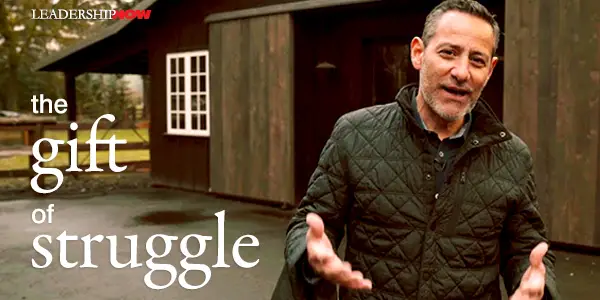
BOBBY HERRERA has a message and the message is “We all struggle. Inside every struggle is a gift. Leaders share their gifts with others.” We tend to not share our struggles or the lessons we learn from them. They are painful and very personal. But Herrera—CEO and cofounder of the HR service company Populus Group—say that’s exactly what leaders do. And that’s why he is sharing his stories and lessons in The Gift of Struggle. One of the core principles at the Populus Group is that “everyone deserves the opportunity to succeed.” It makes sense, and it drove Herrera, but he felt like the people working with him didn’t share his passion and didn’t understand why he did what he did. But once he shared his story—his struggles—they connected, and it gave them meaning. It not only changed the employees but more importantly, it changed him. He understood them better and became a more compassionate leader. If you don’t step up and tell the story that gives you identity and purpose, your people will be left on their own, trying to guess what matters to you and why. Without fulfilling work, they will make assumptions about your mission—or lack thereof—and leave when they find a competitor who offers what you’ve withheld. Until then, they’ll give you just enough to check the box and get through the day. His journey to founding and building the Populus Group is full of ups and downs. But every struggle left him with a gift he used to grow and overcome. The stories he shares are relatable and illuminate the gifts that will help you become a better leader. Here are overviews of some of the gifts you will learn: Share What You Imagine—Build Together: And applying this gift to people, I thought this was eloquently put: It’s is important to realize we are all climbing our own mountains. Everyone you hire started their career climb before you met them, and they will continue climbing for a long time after their tenure with your company is over. All of us are working within our own set of constraints, goals, and unexpected life events that shape our journey. Herrera says, “struggle is the currency of progress.” We need to become students of struggle. Welcome it into our lives as a tool for growth and increased meaning. Strength comes from our struggles. When you view your struggles as a gift, you will become a stronger, more resilient, and more compassionate leader. 
Posted by Michael McKinney at 11:47 AM
07.19.19

3 Ways to Break Out of a Zero-Sum Game of Growth with Your Competitors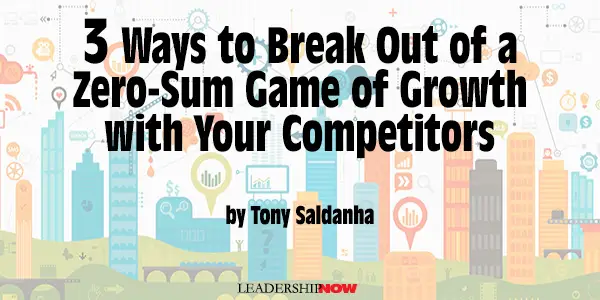
How true disruptors use innovation, including digital, F OR YEARS I was taught that growing the business in an industry with strong competition was mostly a zero-sum game. You took away share from competition or they took it from you. Or else, you took on the hard work of growing the entire market. I’ve learned this is not always true. Many digitally native startups seem to find a third way - a digitally enabled non-disruptive creative growth. That's the beauty of digital capabilities. It can drive new business models, open up adjacent products and help you grow the whole market.1: Open adjacent product areas: For the people across the 147 countries around the world who learned about colors and the alphabet from Sesame Street, there's one more lesson that the beloved TV program can offer. We can learn about how the program created an entirely new segment of preschool “edutainment.” Sesame Street did not disrupt a prior market for childhood education. It created a new one. For more information on this and the concept of non-disruptive creation see this blog post. 2: Create new technology enabled business models: GE’s Jeff Immelt and Dartmouth Professor Govindarajan are back, with lessons on digital transformation. Other than emphasizing that digital transformation is hard work, they make a valid point about how industrial manufacturing firms that used to sell hardware and give the software away for free, have created new business models selling personalized performance-enhancing software too. This article also has good advice to leaders not to talk themselves out of the hard work of digital transformation. 3: Grow the whole market using digital capabilities: Digital disrupters affect their industries in complicated ways. AirBnB did not take market share directly from established chains. According to this article from the US Bureau of Labor Statistics, 42-63% of established hotels probably would not have taken the rooms that AirBnB gained in the lodging business. However, the overall profitability of the hotel industry went down 3.7% with the introduction of AirBnB. While some disruptors can completely change the nature of the industry (as Netflix did with Blockbuster) others slowly change industry profitability and grow the entire market. In either case, Digital Transformation is an opportunity for established companies to play a more innovative role in non-traditional ways. Now, more than ever, you can grow your business in the new and adjacent areas enabled by technology. Go forth and transform.  
Posted by Michael McKinney at 04:04 PM
07.17.19

10 Guiding Principles That Will Lead You to Future Happiness and Success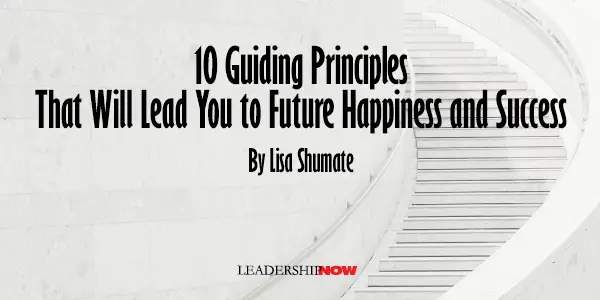
WE SPEND SO MUCH TIME focusing on credentials, experience, intelligence, and presentation. And yet, what is crystal clear to me after 20 years in leadership roles is that those ingredients, while important to success, aren't enough if you've forgotten the fundamentals of being positive, learning from others, being honest and the kind of person people want to work with. I wrote the book Always and Never: 20 Truths for a Happy Heart, to help center readers on guardrails for living and leading at your best. When you step outside of these boundaries, your professional and personal life are likely to suffer, holding you back on both fronts. Read, reflect, and recommit to these Always and Nevers, and realize the kind of future you've been planning for. #1 ALWAYS be in charge of your thoughts What you say and how you feel starts with the way you think. The way you think about everything is in your control. Thoughts are like seeds that need to be watered and nurtured with real knowledge, by real experts and real friends. A curious, open mind lets in the necessary sunshine. Never forget that you are in charge of the way you think and a healthy mind requires ongoing fertilization. #2 ALWAYS listen before speaking And then listen some more. Listen to understand, to demonstrate empathy, and to give the gift of your time and attention. Listen with your eyes as well as your ears. This requires slowing down long enough to truly see the person in front of you. When people want to talk, especially loved ones, they’re rarely seeking answers from you. They want a sounding board, reassurance, and to connect with someone close to them. Never dominate the conversation; you have two ears and one mouth for a reason. #3 ALWAYS follow the Golden Rule Buddhism, Judaism, Hinduism, Confucianism, Christianity, and Islam all subscribe to a version of the Golden Rule in their religious teachings. It’s a simple notion that has endured through the ages. Treat other’s the way you’d like to be treated. Kindness, patience, being first to say I’m sorry are the hallmarks of the Golden Rule, and the rewards to you are long-lasting: inner peace and a life of no regret. Never let the mean acts of others cause you to break the Golden Rule. #4 ALWAYS tell the truth The truth has everything to do with intent. When intentions are pure and not mixed with anything else, there is the capacity for truth. In your daily consumption of information and interactions be aware of sources involved and their potential motives. People who spread rumors and half-truths are always recruiting new members. Never gossip or waste time with those who do. #5 ALWAYS do as you say you will Make your commitments a priority, and you’ll earn something invaluable-- trust. The ability to build and keep trust is worth more than anything else you can bring to the table. There is no skill, degree, or talent that can replace it. Trust is the connective tissue between you and every important relationship in your life: your parents, spouse, boss, coworkers, and friends. Never undermine trust placed in you by others by not keeping your word. #6 ALWAYS place a high value on you The most important relationship you will ever have is the one you have with yourself. Take care of your health and finances on a daily basis. Make your voice the loudest you hear, and the first one you listen to about your hopes and dreams. The compelling force for happiness and success in your life is you and only you. Never allow others to determine your ability and potential. #7 ALWAYS be a student G. Bernard Shaw is credited with the adage “Youth is wasted on the young.” Wouldn’t it be great to preserve all the wonders of youth as we gain the wisdom and knowledge that comes long after high school and college? There is something you can do to maintain your youthful outlook on life—always be a student. Seek out opportunities where you aren’t the smartest person in the room and learn. Read books and magazines that broaden your horizons. Continuing your education in formal and informal ways will keep you young and interesting. Never think you’re too smart or too old to learn something new. #8 ALWAYS separate opinion from fact Opinions are just that, one person’s view. They can be wrapped in fear or prejudice. Opinions can make people as impervious as steel preventing the passage to clear thinking or new possibilities. Keep your mind free of opinions and focus on acquiring real knowledge. Be selective about people who hold themselves out as experts. The best knowledge possible is that which comes from your first-hand research and experiences. Get the facts before you make big purchases, cast your vote, or try to influence others. Never mistake opinion for fact. #9 ALWAYS see the beauty in mistakes Allow yourself to see mistakes in a whole new light. Learn from them, and one day, your mistakes will provide material for the stories you tell, your heartfelt advice to others and your expanding book of self-confidence. Always forgive yourself and others for making mistakes. Make decisions based on the best information you have and be confident you will be able to handle the outcome. Never allow mistakes to cause shame or prevent you from trying again. #10 ALWAYS share credit for success If you want to be known as a team player, to be included in big projects and considered for promotion, look for ways to acknowledge others and their contributions. In fact, the group is always smarter than any one person, so why not embrace it and say so. When you make co-workers feel a part of something, they are inspired to do their best. People who inspire are literally pushed up the ladder by their peers. Never allow your desire for praise overrule recognition for the group. These principles come to you as a loving reminder, moment of reassurance, and reaffirmation of all that is important today and will be for the rest of your life. It comes from someone who has learned through experience these change-proof concepts the hard way. I hope you'll share them with those you love. I hope it brings you comfort, joy and all the blessings of a life well-lived.  
Posted by Michael McKinney at 09:45 AM
07.15.19

Jerry Colonna on True Grit and Other Advice for Leaders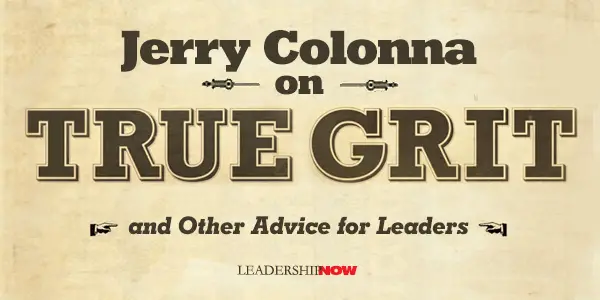
JERRY COLONNA helps start-up CEOs make peace with their demons, the psychological habits and behavioral patterns that have helped them to succeed—molding them into highly accomplished individuals—yet have been detrimental to their relationships and ultimate well-being. In Reboot: Leadership and the Art of Growing Up, he does just that. He states that much of what he has learned about growing up came from learning to lead. Reboot is a peak into his life and the lives of leaders as they come to terms with who they are and what is holding them back. It’s like listening to a coaching session. Who we are shows up in our leadership. Sometimes, we use the organizations we lead to make ourselves feel better about our unresolved issues. When we don’t like what we see, we have to be honest and ask ourselves, how have I been complicit in creating the conditions I say I don’t want? In Reboot, he says things like: The back of the warrior is strengthened by knowledge of knowing the right thing to do. The soft, open heart is made resilient by remembering who you are, what you have come through, and how those things combine to make you unique as a leader. On learning to lead yourself he says: Learning to lead yourself is hard because it requires us to look at the reality of all that we are—not to fix blame on ourselves but to understand with clarity what is really happening in our lives. Learning to lead yourself is hard because it is painful. Growth is painful; that’s why so few choose to do it. A client tells him, “It’s like this—if I’m not panting, I feel like I’m not working.” He responds with: There it is. That same old haunting belief system. Run faster and faster, telling oneself that the way to be is to do; do more, faster, and just maybe you’ll outrun war, cancer, and the other demons that cause you to doubt your worth, your lovability, and your own voice. Colonna challenges leaders to show up as you are. When we stop the bullshitting, the pretending that we’re crushing it, that we’ve got it all figured out, we run the risk of being overwhelmed by the realities of all that we carry—the burdens we’ve convinced must remain secret to keep us and those we love safe, warm, and happy. But the spinning prevents us from being who we really are. You might as well tell me who you are because if you don’t, I’m going to invent things, and those things will stand between us, keeping us from being close. His thoughts on grit are illuminating. He begins by telling us what grit is not: False grit is brittle. It’s the sense that we are nothing if we can’t take a punch. In fact, we define “taking a punch” as the ability to not feel pain when we are pinched. False grit is dangerous. It feeds a stubbornness that, in turn, can feed delusion. We mistake the tendency to delude ourselves that our relationship will improve—our companies will succeed—if only we double down on our old patterns, grip the steering wheel until our knuckles whiten, and bear down. Stubbornness is not the hallmark of the warrior. Leaders who persist out of stubbornness, believing themselves to be gritty, are, at best, delusional and, at worst, reckless. On the other hand, true grit is kind. True grit is persistent. True grit persists not in holding on to false beliefs against all evidence but in believing in one’s inherent lovability and worthiness. True grit is the leader believing in the team’s purpose, its capacity to overcome obstacles, and the relevancy of the cause. True grit acknowledges the potential of failure, embraces the fear of disappointment, and rallies the team to reach and try, regardless of the potential of loss. 
Posted by Michael McKinney at 01:05 AM
07.12.19

Employee Engagement 101: Ask the Holy Question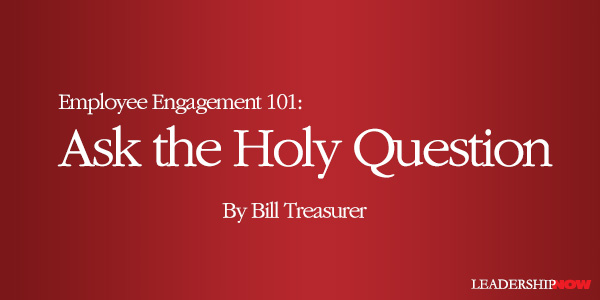
HAVE YOU EVER heard a front-line worker say, “I can’t wait to make more money for our shareholders today!” No? In all my years as a consultant, I haven’t either. It doesn’t matter what your company peddles. Increasing shareholder value, company market share, or worker productivity just doesn’t jazz the average worker. There is often a vast disconnect between what is important to a company’s executive body and what is important to front-line workers. What matters to the average worker includes career opportunity, meaningful work, a balanced life, a fair wage, and being treated with respect—not increasing output. As a leader or manager, you have to attend to the goals of your board or bosses and to the career aspirations of your workers. Too many people in charge focus solely on the former, leaving workers’ aspirations in the dust. A Solution in Four Words Cueing into your workers takes far less time and energy than you’d think. In fact, it only takes four words. They are among the most important words in the English language, and, together, they constitute what I call the Holy Question: “What do you want?” Answering those words, in my opinion, should be required of every job candidate, every worker, and every executive on up the line. The answer to those words should be reviewed during every performance appraisal, succession-planning session, and employee-ranking process. Why? Because when you know what people want, you are in a far better position to match their ambitions and goals to the company’s goals. When company and worker goals are aligned, people pursue organizational goals with the same dedication and passion as they do when driven by self-interest. Aligning Goals Increases Workers’ Courage It’s easier to get people to perform courageous (and uncomfortable) tasks when those tasks tie into their personal aspirations. By knowing what people want to get out of work, you can give them stretch assignments that connect project tasks to their own goals. So, if your boss’s goal is to “repurpose our existing product assets to create new revenue streams and optimize our market dominance on a go-forward basis,” you can tie your boss’s goal to your employee’s own career aspirations by saying, “Hey, John, you said that you want more opportunities to use your creativity. Create ten new business uses for this product by next week.” Or perhaps you know that your employee Michelle would like to move from a data analyst to an advisory role. Your board has come to you needing an informed opinion on the latest sales metrics—and fast. It’s the perfect opportunity to bring Michelle into the fold, allowing her to provide a fresh perspective while simultaneously gaining experience for her dream role. The point is this: Before getting workers to carry out tasks in pursuit of the company’s objectives, you have to understand what is important to them individually. How would you answer the question of “What do you want?” How would your boss answer it? Your customer? Each of your direct reports? Getting each person to answer the Holy Question, with specificity, will help you to know when and how they’ll be willing to be courageous. 
Posted by Michael McKinney at 02:09 PM
07.10.19

How to Be an Engaging Leader in a World of Robotics, AI, and Digitization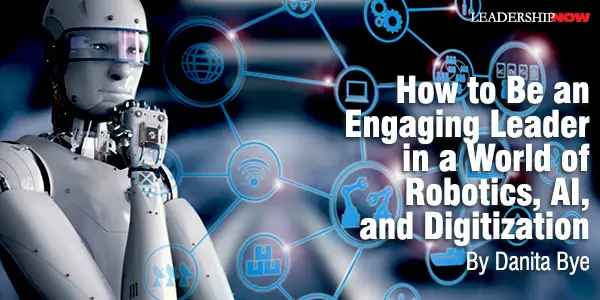
MANY of today’s leaders are saying: I know leadership is about people, not tasks; effectiveness, not efficiency. However, the rapid increase of robotics, AI, and digitization are a disruption. It’s leading us to increased depersonalization and disengagement with our employees. How do I keep the digital demands of today from overwhelming my business? I want to keep my best people engaged, remain competitive, and stay on the growth path! If these are your feelings, you are not alone! Many business leaders are perplexed by the task of leading in an ever-increasing technological world. Yes, we are leaders of people, and yet it feels as if technology and other digital demands keep us from investing in our most valuable resource, our people. In the midst of managing these exponential leaps in technology, there is a war for talent. We are challenged to attract, engage, and retain top-tier millennial talent – the fastest growing segment in our workforce. However, Millennials, the techno-wizards, are not necessarily happy either. Here’s the paradox: Millennials are stepping into a world where one of the things they are good at—technology—may well be one of the things that hurts them most and undercuts their ability to flourish. They are living in a world where the predictions are that robots will soon take over their jobs. It feels as if we’re getting mixed messages from the top. Do we need to choose between attracting and engaging top millennial talent and installing new, state-of-the-art technology? Not every industry needs the latest artificial intelligence, but everyone is feeling the pinch of staying on the leading edge of technology. How can we be an engaging leader in a world of robotics, AI, and digitization? The Benefits of Engaging Leadership According to the 2017 Gallup Workplace Report, employee disengagement is alarmingly high in America. They report that just over 30 percent of participants are engaged (love their jobs), 16 percent are actively disengaged (miserable and destroying what others are building), and 51 percent are not engaged (they’re just there). In 2016, the Society for Human Resource Management made a compelling case about the benefits that come from an engaging leadership approach: • 22 percent greater profitability
Millennials are reminding us of what the research shows – no matter how important the new AI or robotics system is, in order to attract, engage, and retain them, we need to do three important things. Prioritize the Person, as Well as the Technology “I want to be treated as an individual – not as a trend or a robot.” Listen deeply. Listening is a tangible action that engaging leaders employ to demonstrate that they value the Millennials in their sphere of influence. They listen…then collaborate on how they might support their emerging leader’s goals to leverage their strengths, nurture their natural skills, and achieve their career goals. Here’s the challenge. As experienced leaders, we have a wealth of knowledge, wisdom, and insight that we are excited to share with our younger counterparts. But what happens when we talk, and talk, and talk…and don’t listen? Our emerging leader loses trust. Then, they disengage. Why? Trust is at its lowest when we talk 75 – 80 percent of the time, and listen only 20 – 25 percent of the time. What might happen if we spent 20 – 25 percent of our coaching and managing time asking insightful, probing questions, and then listening? Practical experience has proven that active listening improves collaboration, deepens relationships, and boosts productivity. By prioritizing and seeking to understand what makes your emerging leader flourish, you spark engagement. Plus, you will gain even further insights from them on how to leverage technology to gain to tap new markets, gain market share, and enhance the customer experience. Align Vision and Values “I want to understand your vision and values so that I know how I’m making an impact. I want to be part of something bigger than the job you’ve hired me to do.” Tapping into the goals, dreams, and aspirations of their Millennials – and create align with their company’s vision and values – is a driver for engagement focused leaders. Emerging leaders often feel stuck and can’t see beyond the perceived drudgery of their ToDo List. They may struggle seeing how their everyday work has meaning and purpose. The result? Disengagement. Reverse this trend by helping them see how they, and the work they are doing, fits into your company’s larger purpose. The clearer the picture is to them on how they are helping your customers and how they are making the world a better place, the more engaged they will be. They will live with high regard for their work, bringing fresh, human compassion, insights, and connection to a high-tech world. Value Two-Way Mentoring “I want to be more than a digital number in your database who gets a monthly paycheck. I want leadership that values my opinion and is geared to my career development opportunities.” Two-way mentoring means that we seek not only to teach and train our emerging leaders, but also to learn from them. Millennials thrive when they get clear guidelines and feedback that shines a bright light on what they’re doing right. This creates a learning pattern for them of recognizing their strengths, re-creating it, and refining it. Bring them into brainstorming and problem-solving processes. Their insights can assist you in developing new products and services, as well as create openings in new markets. We might not want to admit it, but they have important insights for us to consider that test and rethink our own paradigms about how to lead well in the rapidly shifting world. Summary The disruption of digitization, robotics, and AI is here to stay. That does not mean that your role as a leader of people will become obsolete. In fact, your role will become even more indispensable. As the war for talent continues, you can come one step closer to winning that war by becoming an engaging leader. The time has come to start listening to the emerging leaders so that we learn about their strengths. Give your Millennial clarity on his or her role, and create a win-win scenario by establishing yourself as a leader who wants to learn. You have the experience and resources to counteract the depersonalization and disengagement phenomenon. Keep your best people engaged, remain competitive, keep up with the demands of technology, and be poised for growth!  She is a member of Forbes Coaches Council, is a leadership and sales development expert and author of the new book, Millennials Matter: Proven Strategies for Building Your Next-Gen Leader.
Posted by Michael McKinney at 10:20 AM
07.08.19

Nick Saban on the 5 Choices We Have in Life
THE 2019 Clinic of Champions held in April and hosted by Alabama head coach Nick Saban and the Crimson Tide football coaching staff featured a number of speakers from around the NFL including Cleveland Browns head coach Freddie Kitchens. Kitchens explained in his presentation what it takes for good players to become great. It was meant for coaches, but the principles apply to us all across the board. Saban shares his takeaway from that presentation: Freddie Kitchens made an interesting statement last night when he spoke to the clinic, and I actually shared it with the players today. The kind of excellence that Kitchens and Saban are talking about is not easily won. Excellence comes from a fanatical attention to basics. Little things make up the big things. Like the painting by Seurat, many points of activity conspire to produce a single effect. Details done right—at a high level—create excellence. One of those many points comes down to steadfastly acting instead of reacting to any condition you are faced with. That’s driven by consistently keeping the focus on where the team is headed and not where it has been.

Posted by Michael McKinney at 12:51 PM
07.05.19

Grace: A Leader's Guide to a Better Us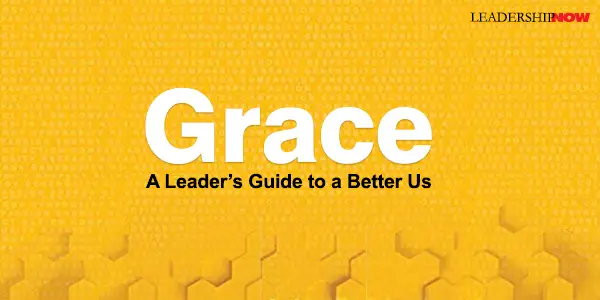
GRACE, a concept present in all of the world’s major religions, has a divine meaning. Grace, in a secular sense—that is on a human level—is about perspective. A perspective larger than ourselves. A perspective that reaches to a purpose beyond who we are alone. In short, our connectedness. Grace is a critical part of who great leaders should be. To that end, John Baldoni has tackled for us in Grace: A Leader’s Guide to a Better Us, an attribute that is in short supply today. Grace is something all leaders should model for the benefit of those around them so that it spreads to society in general. Grace is foundational to service. Baldoni writes: Love, sacrifice, truth, and courage are virtues made actionable by grace. We may be disposed to do what is right; grace gives us the impetus to act upon doing it. Grace then becomes the inspiration for treating individuals with generosity, respect, and compassion. It manifests itself as action in the name of others, and it energizes us to act upon our beliefs. To help us better understand grace and to help us intentionally apply it in our leadership, Baldoni explores grace from five perspectives with this acronym: G is for Generosity: the will to do something for others.
Generosity Gracious people give of themselves. Gracious people leverage who they are and what they have for the benefit of others. Baldoni shares a great quote from British Prime Minister Benjamin Disraeli, “The greatest good you can do for another is not just to share your riches but to reveal to him his own.” Gracious leaders share time, knowledge, and power. They cultivate a selfless approach to life. Generosity emanates from an abundance mindset. A selfless person, even in the midst of personal adversity, can find something to share with others. That attitude is contagious. Respect Self-awareness opens the door to respect for others. A fully self-aware person knows her faults as well as her strengths. Such awareness compels the self to acknowledge the dignity of others.” Humility plays a big part here. Respect and self-respect fuel each other. They grow together. Action Grace is intentional. A reactive mind rarely manifests grace. While grace that has been shown to us comes freely, it requires effort for us to generate it ourselves. Grace means rising above a perceived slight. Grace is often manifested in clarity of purpose and civility. Civility is a decision we make. “No matter what leaders may feel inside, they think before they speak. They focus not on themselves, but on the needs of others—on healing.” Instilling civility in the workplace is the job of leaders. Compassion Gracious people have the capacity to forgive and show mercy. “Grace enables us to take the higher road, to think more clearly.” It meets rage with love and civility. Gratitude enables compassion—both gratitude expressed and felt. “Gratitude is that capacity to care. We need to reframe our lives with a constant awareness of just how important feeling gratitude within ourselves is because it actually helps our overall well-being.” Energy Grace requires energy. “It renews itself through practice as well as by taking in life, doing one’s best, enjoying the highlights, mourning the losses, and do so in the full spirit of life. In forgiveness, mercy, joy, and humor.” Grace draws energy from a positive outlook and an abundance mindset. When we demonstrate grace in our leadership, it spills into other areas of our life as well because it is an approach to life. Our example encourages others to begin to think that way as well. Grace—in all of the dimensions Baldoni explores in this book—is a value that has fallen on hard times. It is time to revive it in our personal lives, in the workplace, social media, and in public discourse. Grace celebrates grace as well as advocates for it. Baldoni shares many examples of people from all walks of life who demonstrate grace in their lives. They are an inspiration to us all. Grace reduces the space between us. Our environment often pushes us into negativity; into the differences between us. Grace intentionally overlooks the negative and leverages the positive. It finds the connection and promotes it. Baldoni breaks the often intangible idea of grace into down-to-earth actionable behaviors that we can all intentionally implement into our lives. You will find a self-assessment tool of 20 questions to help you take an honest look at how much you have allowed grace to fill your thoughts and behaviors. 
Posted by Michael McKinney at 01:08 PM
07.03.19

The 24 Hour Rule: Is Your Current Pace Sustainable?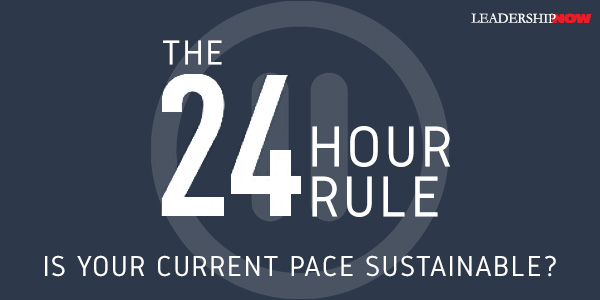
AS LEADERS, we can and do introduce stress into the workplace. Charles Fred initiated a study of over 4000 post-startup business to find out why, after they had experienced early growth, had stagnated. What the researchers found is a problem in the way employees approached their roles, solved problems, and interacted with each other; poor-performing firms showed working environments of intense stress.” The responsibility for that rests on those that influence how others work and interact within the workplace—the leaders. Our culture baits us into a non-stop frantic pace with the inevitable unintentional behaviors. Many leaders believe that they are just setting the bar for high performance. Our bodies react by producing cortisol and adrenaline to help us keep up, but over time it becomes unproductive stunting the “very tool we need to prosper in today’s environment: our cognition. So, when we require mental acuity, we experience diminished recall. When we need sharp thinking and problem-solving, our minds are full.” Into this environment, Charles Fred introduces a leadership discipline that inserts pause and calls it The 24 Hour Rule. “The discipline of pause focuses on the simple notion of creating a space between you and the persistent and perilous stimulus from a frenetic world.” It is the role of the leader. Pause is not a delay but a discipline. It’s not a waste of time; rather, it affords us the time to deliberate before we act. It allows us to control how we respond and react to others, whether it takes five seconds or 24 hours. Most importantly, it does not delay our ambitions or dampen the need to hustle. It is the one thing we have complete control over. Fred writes, “I’ve learned that I can truly only regulate one thing: the way in which I respond and react to another human.” When we look at the highlight reel of successful people, it gives us the impression that they are always on—always producing. As we watch from the sidelines, we create for ourselves a false set of expectations. We introduce unnecessary stress into our lives and work as we try to keep up. The thing is, it’s not real. Top producers insert pause into their work. We need the self-discipline to do the same by letting go of a false ideal. The 24 Hour Rule is a well thought out and well-executed booklet. Fred provides three steps for building self-discipline around pause. It is a quick read but one that is worth spending some time thinking about. How will you introduce pause into your leadership? 
Posted by Michael McKinney at 06:48 AM
07.01.19

First Look: Leadership Books for July 2019Here's a look at some of the best leadership books to be released in July 2019. Don't miss out on other great new and future releases.
The Coffee Bean: an illustrated fable that teaches readers how to transform their environment, overcome challenges, and create positive change. Life is often difficult. It can be harsh, stressful, and feel like a pot of boiling hot water. The environments we find ourselves in can change, weaken, or harden us, and test who we truly are. We can be like the carrot that weakens in the pot or like the egg that hardens. Or, we can be like the coffee bean and discover the power inside us to transform our environment.
The true, behind-the-scenes history of the people who built Silicon Valley and shaped Big Tech in America. Now, after almost five years of pioneering research, O'Mara has produced the definitive history of Silicon Valley for our time, the story of mavericks and visionaries, but also of powerful institutions creating the framework for innovation, from the Pentagon to Stanford University. Deploying a wonderfully rich and diverse cast of protagonists, across four generations of explosive growth in the Valley, from the Forties to the present, O'Mara has wrestled into magnificent narrative form one of the most fateful developments in modern American history.
In Follow the Feeling, strategy advisor Kai D. Wright answers a critical question plaguing entrepreneurs, brand strategists, marketers, and leaders: how do you grow your brand in a noisy world? Analyzing 1,500 fast-growing companies from Alibaba to Zara, the Columbia University lecturer and Ogilvy global consulting partner unpacks five branding secrets. Follow the Feeling will show you how to best build and position your brand so you can stand out from competitors, build a tribe, and engineer a positive feeling across five important branding territories—lexicon, audio cues, visual stimuli, experience, and culture.
In an increasingly experience-driven economy, companies that deliver great experiences thrive, and those that do not die. The book presents interdisciplinary research underlying key concepts such as memory, intentionality, and dramatic structure in a down-to-earth style, drawing attention to both the macro and micro levels. It provides readers with the tools they need to design innovative and indelible experiences and to move their organizations into the experience economy.
A fascinating story about the power of networking, connection, and mentorship. Written as an engaging parable, Swim! How a Shark, a Suckerfish, and a Parasite Teach You Leadership, Mentoring, and Next Level Success brings to life real-world challenges (and their solutions) and presents them in simple, yet powerful terms. The book explores the vital importance of networking, explores the steps that lead to successful networking, and explains why we need it.
On August 9, 1974, Richard Nixon became the first and only U.S. president to resign from office—to avoid almost certain impeachment. Utterly disgraced, he was forced to flee the White House with a small cadre of advisors and family. Richard Nixon was a completely defeated man. Yet only a decade later, Nixon was a trusted advisor to presidents, dispensing wisdom on campaign strategy and foreign policy, shaping the course of U.S.-Soviet summit meetings, and representing the U.S. at state funerals—the very model of an elder statesman. How did he do it? Kasey S. Pipes, advisor to President George W. Bush, tells the fascinating story of Nixon’s comeback.
 Build your leadership library with these specials on over 39 titles. All titles are at least 40% off the list price and are available only in limited quantities. “You're the same today as you'll be in five years except for the people you meet and the books you read.” — Charlie "Tremendous" Jones
Posted by Michael McKinney at 12:38 AM
|
BUILD YOUR KNOWLEDGE


How to Do Your Start-Up Right STRAIGHT TALK FOR START-UPS 
Grow Your Leadership Skills NEW AND UPCOMING LEADERSHIP BOOKS 
Leadership Minute BITE-SIZE CONCEPTS YOU CAN CHEW ON 
Classic Leadership Books BOOKS TO READ BEFORE YOU LEAD |
|